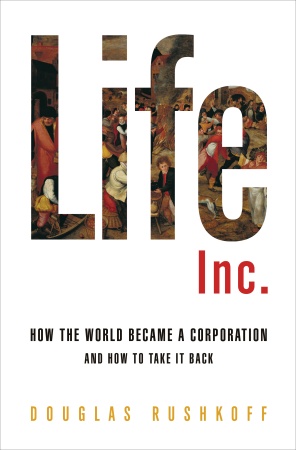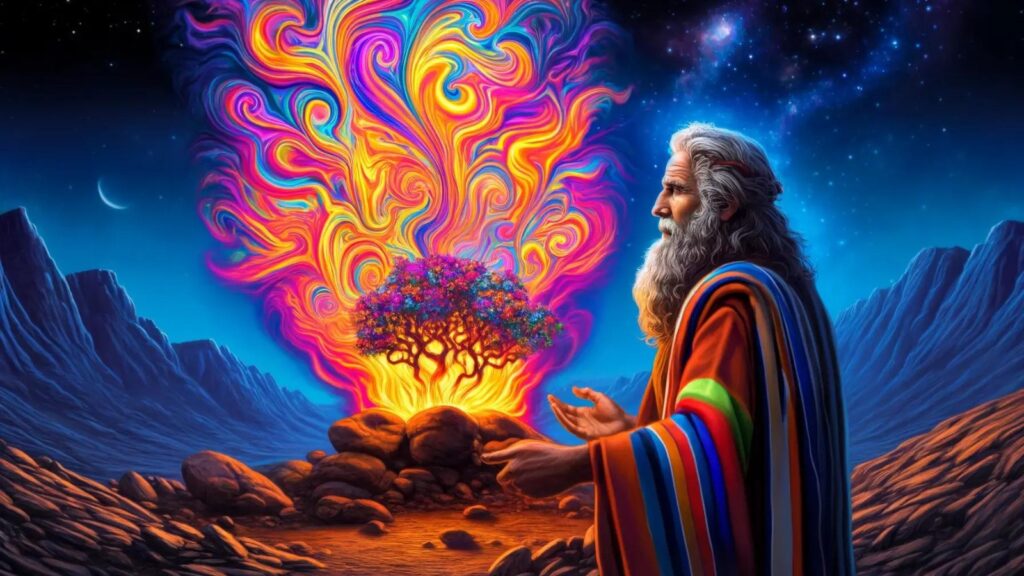This article is excerpted from Life Inc., recently released by Random House.
While you might expect the marriage of progressive sociopolitical goals and the culture of spirituality to ground activism in ethics, it turns out that just the opposite is true. That’s because what we think of as “spirituality” today is not at all a departure from the narcissistic culture of consumption, but its truest expression. Consumer materialism and spirituality coevolved as ongoing reactions against the seemingly repressive institutions of both state and church.
The Puritans brought the late-Renaissance ideology of boundless frontiers with them to the new continent as Calvinism. While we associate the Puritan ethic with hard work, proper investment, and devotion to charity, all this insurance for one’s soul also promised a totally earthly gratification. Their ascetic renunciation was supposed to yield Puritans a material bounty, and their human prosperity in this world was likewise a sign of their spirit’s salvation in the next one. Not surprisingly, then, the brand of Protestantism that developed in America as corporations took hold in the mid- 1800s was already consonant with capitalism’s requirements for infinite growth and exploitation of material bounty.
John D. Rockefeller saw his monopolies as endowments from the Creator: “I believe the power to make money is a gift from God . . . to be developed to the best of our ability for the good of mankind. Having been endowed with the gift I possess, I believe it is my duty to make money and still more money, and to use the money I make for the good of my fellow man according to the dictates of my conscience.” Rockefeller treated his double- entry accounting ledgers as “sacred books that guided decisions and saved one from fallible emotions.”
The department-store magnate John Wanamaker saw in American Protestantism an emphasis on how people behaved rather than what they believed. He saw no contradiction, but a complete synergy between the sacred and the worldly –between devotion and consumption. Wanamaker expanded the Bethany Mission Sunday School, funding concerts, classes, and decorations — much the same kinds of innovations he brought to his department stores. He invited an evangelist preacher, Dwight Moody, to hold a revival meeting “tailored more than any that preceded it to the needs of business and professional people who wanted to be freed from the guilt of doing what they were doing.” Religion became a way to support capitalism and purge reflection. The poor should not be helped in any case, lest their immorality be rewarded. Books like Charles Wagner’s The Simple Life criticized the social programs we now associate with churches, because they involve the redistribution of wealth, which was a repudiation of the way God had given it all out. Instead, everyone should just avoid “pessimism” and “analysis,” and be “confident” and “hopeful.”
Developing parallel to all this were the first stirrings of what we could call the American spiritual movement, or “mind cure,” to which Wanamaker’s window dresser, L. Frank Baum, belonged. In the 1893 Parliament of Religions at the World’s Columbian Exposition in Chicago, the great mind- cure healers were all brought together for the first time. These were the original practitioners of what we could call the “new age,” bringing together the values of consumerism with that of spiritual healing. Baum’s own guru, the theosophist Helene Blavatsky, was there, right alongside Mary Baker Eddy (the founder of Christian Science) and Swami Vivekananda (the founder of the Vedanta Society). These spiritualists engaged in pretty esoteric practices. The Russian Blavatsky claimed that she could levitate, project herself out of her body, and produce physical objects out of thin air. Mary Baker Eddy healed ailing farm animals as a child, and later taught people how to heal one another through exposure to Christ Truth. Vivekananda introduced yoga to the West, by pairing it with his particularly American- friendly notion that “Jiva is Shiva” — the individual is divine. By completely removing the traditional and institutional undertones from spirituality, they allowed their followers to embrace the here, the now, and, most important, the self as never before, democratizing happiness and, not coincidentally, condoning consumption as a form of making oneself whole.
The new cult of personal happiness through bootstrapping found its way into every arena, most famously into children’s literature, where it could take on mythic significance for successive generations. Eleanor Porter’s Pollyanna, one of John Wanamaker’s favorite tomes and a testament of the simple- life philosophy, tells the story of a young orphan who sees gladness everywhere. Regardless of any hardship imaginable, the girl experiences happiness and soon infects others with her irrepressible sense of joy. See it, feel it, be it. The universe will follow. In L. Frank Baum’s The Wonderful Wizard of Oz, we get theosophy through the lens of a window trimmer. He Americanizes the fairy tale, softening violence and misfortune with color and abundance. The Wizard in the Emerald City can provide anything to anyone, and especially to pure- hearted Dorothy as long as she believes. It is mind cure at its best: carpe diem. And it quickly became a foundation myth for the new spirituality of self.
Despite its antiauthoritarian and self-affirming style, the mind-cure movement didn’t offer a genuine alternative to American Protestantism, or a break from its manufactured individualism. Both movements focused on the salvation of the self — one through grace, the other through positive thinking. Throughout the twentieth century, personal freedom would become the rallying cry of one counterculture or another, only serving to reinforce the very same individualism being promoted by central authorities and their propagandists. We were either individuals in thrall of the masquerade, or individuals in defiance of it. Corporatism was the end result in either case.
The mind-cure movements of Blavatsky and Eddy launched a self-as-source spirituality that dovetailed ever so neatly with the individualism promoted by corporate marketers and their psychology departments. Freud and his daughter Anna had led corporate psychologists to believe they could tame the irrational secret self by giving people symbols of power in the form of private houses, personal territory, and consumer goods. Another school of psychologists, taking their cue from Freud’s former student Wilhelm Reich, took the opposite approach — or so they thought. Reich believed that the irrational inner self wasn’t dangerous unless it was repressed, and that the Freuds’ techniques did just this. These innermost impulses weren’t violent; they were sexual. They should be liberated, according to Reich, ideally through orgasm.
Anna Freud — herself a virgin who had been analyzed by her father for practicing excessive masturbation — was committed to her father’s legacy, and determined to take Reich down. She discredited his work and got him kicked out of the International Psychoanalytical Association. He was later treated as a madman and imprisoned. The court ordered that all his books and records be burned. The battle lines in the psych wars were drawn — but both sides were ultimately fighting for the same thing.
By the 1960s, the German philosopher Herbert Marcuse had revived much of the spirit of Reich — this time for an audience already dissatisfied with the spiritual vacuum offered by consumerism. He was the most vocal member of the Frankfurt School, and spoke frequently at student and antiwar protests. Marcuse blamed the Freudians — as well as the government and corporate authorities who used their stultifying techniques — for creating a world in which people were reduced to expressing their feelings and identities through mass- produced objects. He said the individual had been turned into a “one- dimensional man” — conformist and repressed.
Marcuse became a hero to the real counterculture movement, and his words inspired the Weathermen, Vietnam War protests, and the Black Panthers. They saw consumerism as more than a way for corporations to make money; it was also a way to keep the masses docile while the government pursued an illegal war in Southeast Asia. So breaking free of the consumption- defined self was a prerequisite to becoming a conscious protester. As Linda Evans of the Weathermen explained, “We want to live a life that isn’t based on materialistic values, and yet the whole system of government and the economy of America is based on profit, on personal greed, and selfishness.” But as Stew Albert, a cofounder of the anti- Vietnam movement the Yippies, contended, the police state began in an individual person’s mind. People who sought to be engaged in political activism needed first to make themselves new and better people.
The counterculture and its psychologists again revived the spirit of Wilhelm Reich in the hopes of freeing people from the control of their own minds. To this end, in 1962 the Esalen Institute was founded on 127 acres of California coastline. The Institute hosted a wide range of workshops and lectures in an atmosphere of massage, hot tubs, and high- quality sex and drugs, all in the name of freeing people from repression. The Human Potential Movement — Renaissance individualistic humanism updated for the twentieth century –began in an explosion of new therapies. Fritz Perls taught people how to kick and scream while George Leonard conducted “encounter sessions” between black and white radicals, and another with nuns from the Immaculate Heart Convent in Los Angeles — a majority of whom discovered their sexuality and quit the order immediately afterward.
Underlying all of this therapy and liberation was a single premise: Esalen hero Abraham Maslow’s “hierarchy of needs.” The Brooklyn-born psychologist’s map for the individual’s journey to more liberated states of being held that people needed to fulfill their lower needs for food, shelter, and sex before they could work on higher ones such as self- esteem and confidence. At the very top of Maslow’s pyramidal chart sits the ultimate human state: “self- actualization.” For Maslow and his followers, the goal of the self- actualizer was autonomy, independent of culture, environment, or extrinsic satisfactions. Agency, personal creativity, and self- expression defined the actualized “self.”
Like Dorothy embarking down the yellow- brick road to self-fulfillment, thousands flocked to the hot tubs of Esalen to find themselves and self-actualize. Instead of annihilating the illusion of a self, as Buddha suggested, the self-centered spirituality of Esalen led to a celebration of self as the source of all experience. Change the way you see the world, and the world changes. Kind of. Instead of fueling people to do something about the world, as the Weathermen and Yippies had hoped, spirituality became a way of changing one’s own perspective, one’s own experience, and one’s own self. By pushing through to the other side of personal liberation, the descendants of Reich once again found self- adjustment the surest path to happiness. Anna Freud would have been proud. You are the problem, after all.
The self- improvement craze had begun. Instead of changing the world, people would learn to change themselves. Taking this as their central operating premise, the students of Fritz Perls, Aldous Huxley, and the other Esalen elders developed increasingly codified and process- driven methods of achieving self-actualization. David Bandler introduced the Esalen crowd to what he called Neuro-Linguistic Programming, or NLP. Part hypnosis, part behavioral therapy, NLP sees the human organism as a set of learned neural patterns and experiences. By reframing one’s core beliefs, a person can relearn reality. The NLP practitioner is a kind of hypnotist who can help reprogram his patients by changing their “anchors,” “associations,” and “body language.”
This work trickled down both directly and indirectly to Werner Erhard and Tony Robbins, who democratized these self- actualization technologies even further through their workshops for EST (now the Landmark Forum) and Unleash the Power Within. Erhard based his seminars on an insight he had gained as a used-car salesman: people weren’t buying cars from him at all — they were buying something else that they were simply projecting onto the car. When he was doing his sales job properly, he was just selling people back to themselves. So why not do this without the cars at all?
“The purpose of the EST training,” we were told when I took it as a college student in the early ’80s, “is to transform your ability to experience living so that the situations you have been trying to change or have been putting up with clear up just in the process of life itself.” Get it? The point is not to work on the outward circumstances, but on the inner obstacles to experiencing life in a fundamentally different way. Even if the insight had some value for certain people, the benefits of the EST experience were soon outweighed by the tremendous obligation to “enlist” others in the program. Instructors insisted that the only way to “get it” was to bring others into the pyramid. And if one did “get it,” why wouldn’t one want to share it with friends and family?
Tony Robbins’s Unleash the Power Within seminars explicitly married self-improvement with wealth and power. By walking across hot coals, his seminar participants were supposedly demonstrating to themselves the power of mind over matter and, presumably, over money and other people. While the initial focus of this commercial form of NLP may be on self-hypnosis, one only needs as much of that as is necessary to justify the hypnosis of others. That’s why the focus of most NLP today is on applying it to sales, advertising, and even influencing jury selection and deliberation.
While the Yippies and Vietnam protesters were becoming self-actualized NLP programmers, Madison Avenue was retooling its campaigns to these new, highly independent consumers. Daniel Yankelovich, a leading market researcher, studied the apparently nonconformist people of the 1960s and 1970s, and realized that they weren’t anticonsumerist at all. They simply wanted products that expressed their individuality, their self- direction, their self-actualization. Luckily for American industry, mass production had developed to the point where Detroit could turn out a brand of car for every member of the family, in any number of psychedelics-influenced colors. The Stanford Research Institute hired Abraham Maslow to turn his hierarchy of needs into psychographic categories of American consumers, applicable to marketing.
It’s not that the self-help movement sold out. It was sold out to begin with. First imported from the East by mind-cure fans like L. Frank Baum to help rationalize the marketing of illusion as an ethical pursuit, the “religion of no-religion” was nothing more than a change in perspective. A new set of self- as- source glasses through which to see: Pollyanna’s.
Making money off the new spirituality is not a corruption of this movement’s core truths, but their realization. In that sense, the obligation of Landmark graduates to enlist their friends in multi-thousand-dollar courses really does confirm the teachings of Werner Erhard. In their logic, the refusal to do so indicates a weakness, an inability to master the energy of money, or a difficulty communicating with one’s friends from a place of power. The woman taking Km tonic or wearing magnetic jewelry passes it on to others more as a way of confirming her own belief in its efficacy than to help her friends. But it’s a win-win, because the friends will be helped, too. A win-win-win, in fact, because she’ll get to keep some of the profit as she passes the proceeds up to her supplier.
Every new self-help modality is an opportunity for a new pyramid of wealth-building as it is shared with successive groups of beneficiaries. The patient of a healer first pays to be healed, then pays even more to learn the technique and heal others. Finally, if he’s lucky, he can move to the top of the pyramid and charge still others to be healed themselves. Like residents at a teaching hospital, New Age practitioners “watch one, do one, teach one.” And at each successive place in the hierarchy, the practitioner has invested more time and money. No one who takes enough courses to become a certified reader of auras will be caught dead saying they don’t really exist. Besides, seeing is believing.
Getting past any guilt, shame, or ethics, today’s self-help practitioners no longer consider profit to be a happy side effect of their work, but its raison d’être. The Courage to Be Rich: Creating a Life of Material and Spiritual Abundance, by the TV wealth advisor and bestselling author Suze Orman, ties psychology, spirituality, and finances together into a single, one-size-fits-all approach to the universe that hinges on our relationship to cash. Esalen, the Omega Institute, and other spiritual retreat centers fill their catalogs with workshops by Malcolm Gladwell on “Being Fearless,” Jack Canfield on “Success Principles,” and, of course, everyone on The Secret.
Organized religion well understands the new competitive landscape, and offers its congregations just as much personal success as any self-improvement huckster. The televangelist Creflo Dollar (that’s his real name) blings the word to his followers: “Jesus is ready to put some money in your pocket. . . . You are not whole until you get your money. Amen.” Dollar may be the epitome of the “prosperity gospel,” which promotes the “total” enrichment of its followers. Megachurches are megacorporations, whose functioning and rhetoric both foster the culture and politics of the free market. Christian branding turns a religion based in charity and community into a personal relationship with Jesus — a narcissistic faith mirroring the marketing framework on which it is now based. Megastar and multimillionaire televangelist Joel Osteen, “the smiling preacher,” prays for raises and bonuses for members of his congregation, and promises that people will find material success through faith. And keep finding it as long as they believe they will.
For it’s no longer good enough to make a lot of money. In a society of ever-improving selves, the individual must become a moneymaking entity all its own. As Chicken Soup pusher Canfield says, “The desire for increase is the fundamental. Expansion is the true nature of the universe. More. The soul is attempting to express itself in a higher way.” One can’t simply earn “enough” and then stop. Like the economy and the universe, a person’s wealth must grow. It’s only natural.









